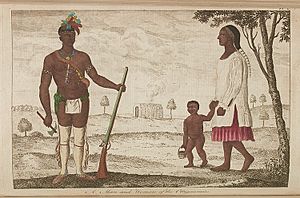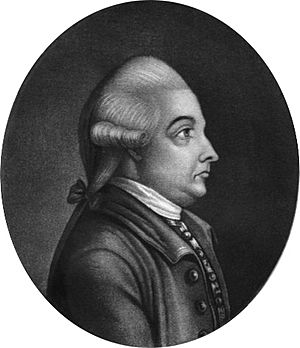Jonathan Carver facts for kids
Jonathan Carver (April 13, 1710 – January 31, 1780) was an American explorer, writer, and a captain in the military. He explored the northern Mississippi River valley and the western Great Lakes region. Later, he wrote a popular book about his adventures. This book, called Travels through America, made many people interested in these new lands.
Carver was born in Weymouth, Massachusetts in 1710. His parents were David and Hannah Carver. His family later moved to Canterbury, Connecticut. We don't know much about his schooling. However, he learned to read and write. He also taught himself how to survey land and make maps. He even worked as a cobbler, making and fixing shoes.
In 1746, Jonathan married Abigail Robins. They had five children together. Around 1748, his family moved to Montague, Massachusetts. This was a small settlement on the edge of the wilderness. There, he helped manage local town affairs.
Contents
Joining the Military
In 1755, Carver joined the Massachusetts colonial army. This was at the start of the French and Indian War. In 1757, he joined a group called Burke's Rangers. This group later became part of Rogers' Rangers. During the war, he learned more about surveying and mapping.
Carver was good at military work. He became a captain in a Massachusetts regiment in 1761. Two years later, he left the army. He wanted to explore the new lands that Britain had gained. France had given up its territory east of the Mississippi River to Great Britain.
Searching for the Northwest Passage
At first, Carver could not find anyone to pay for his trips. But in 1766, Robert Rogers hired him. Rogers wanted Carver to find the Northwest Passage. This was believed to be a water route across North America to the Pacific Ocean.
Finding this route was very important. The king and Parliament had promised a huge prize of gold for its discovery. The usual way to the Pacific was around the Cape of Good Hope in Africa. That route was very long. Also, other European countries often fought over it.
Carver's Explorations
From 1766 to 1767, Carver explored parts of what are now Wisconsin, Minnesota, and Iowa. He mainly traveled along the upper Mississippi River. When he returned east, his efforts were not fully recognized. In 1769, he sailed to England. He hoped to get paid for his work. He stayed there for the rest of his life.
In 1778, Carver published his book about his travels. It became very popular. He died in 1780. After his death, some of his family claimed he had received a large land grant. They said two Sioux chiefs had given him land in eastern Wisconsin. However, this land grant was not legal. It might have even been a trick made up after he died.
Places Named After Carver
Several places are named in honor of Jonathan Carver. These include Carver, Minnesota and Carver County, Minnesota. The Jonathan Association in Chaska, Minnesota is also named for him. These names recognize his important work exploring and mapping the region.
His Journey and Discoveries
Carver began his main journey in the spring of 1766. He left from Fort Michilimackinac in what is now Mackinaw City, Michigan. He used large canoes, like those used by fur traders. He followed the well-known trade routes used by the French.
His route took him along the northern coast of Lake Michigan. He then crossed to the Door Peninsula in Wisconsin. He continued along the western edge of the bay. Finally, he reached what is now Green Bay, Wisconsin.
Carver visited a small Métis settlement near Green Bay. He also saw a French monastery nearby. He got more supplies there and kept going. He traveled up the Fox River to a Ho-Chunk (Winnebago) village. This village was at the north end of Lake Winnebago. Today, the city of Neenah, Wisconsin is there.
He continued up the Fox River to the "Grand Portage." This was a well-used path between the Fox and Wisconsin rivers. It was a major place for fur trading. From here, furs could be sent from the Great Lakes to the Wisconsin River. Then, they went south along the Mississippi to New Orleans.
Carver crossed to the Wisconsin River. He then traveled down the Mississippi. He reached a large trading camp at Prairie du Chien, Wisconsin. Instead of going south, his group turned north into what is now Minnesota. By late summer, he reached the Saint Anthony Falls near modern-day Minneapolis.
He spent some time with a tribe near the falls. Then, he turned south down the Mississippi. He wanted to find a better place to spend the winter. During this part of his trip, he found what is now called Carver's Cave.
He spent the winter in a tribal village in eastern Iowa. The next spring, he met James Tute and James Stanley Goddard. They had been sent to join Carver. They kept exploring and mapping the upper Mississippi River. This included parts of what are now Minnesota and Wisconsin.
The men headed for Grand Portage on Lake Superior. They hoped Robert Rogers had sent supplies there. But instead, they found a letter from him. He told them they were spending too much money. Without the needed supplies, they went back to Fort Michilimackinac. They arrived there on August 29, 1767.
Carver learned that his sponsor, Governor Robert Rogers, was suspected of treason. On December 6, 1767, Rogers was arrested. He was put in prison. Carver likely used this time to get his travel journal ready for printing.
In the spring of 1768, Carver and Rogers traveled to Detroit. Rogers was later tried in Montreal but was found not guilty. Carver asked for his travel expenses to be paid. But his request was denied. They said Rogers did not have the power to order such a trip.
Carver was very upset. He believed the government had hired him to map new lands. He also thought he might have found a Northwest Passage. He had worked for two years. He was left with only debts, maps, and log books. No one seemed interested. In 1769, Carver went to England. He wanted to ask the government for his promised payment. He also wanted the reward for finding a possible Northwest Passage.
He left his wife Abigail in the colonies. He never saw her again. He spent the rest of his life asking the English government for his payments. He eventually received two payments to cover his costs. However, he did not get the big reward for the Northwest Passage. While working on this, he wrote his Travels book. It was published in 1778. He also started a new family in London.
Carver's Famous Book

Carver's book, Travels Through the Interior Parts of North America in the Years 1766, 1767, and 1768, was very popular. It was first published in 1778. Many copies were printed, and it was translated into several languages. This book was very important for understanding the exploration of the American West. Carver was the first English-speaking explorer to go west of the upper Mississippi River.
He was also the first to talk about a large mountain range to the west. This was likely the Rocky Mountains. He said it blocked the way west and divided the continent. The name 'Oregon' appeared in his book for the first time. It was in both the text and on one of his maps.
Carver traveled farther west than any other English explorer before the American Revolution. His book made people curious about routes to the Pacific. Later, explorers like Alexander Mackenzie and the Lewis and Clark Expedition answered these questions. The book became very famous. However, Carver did not get rich from it. He died poor in London in 1780.
Some experts have questioned how accurate Carver's book is. His original journal is different from the published book. More recent studies suggest Carver did make the trip he described. But he did not mention that he was hired by Governor Robert Rogers. Instead, he made it seem like he explored on his own.
In 1906, a historian named E.G. Bourne wrote about Carver's book. He said that much of the book was taken from other writers. These included Charlevoix, Adair, and La Hontan. Whole chapters seemed to be copied almost word for word from their works.
The Carver Land Claim
After Carver died, a doctor named John Coakley Lettsom bought the rights to his book. He published a third edition in 1781. He said it was "for the relief of the widow and children," meaning Carver's family. Lettsom claimed he had a paper signed by two Sioux chiefs. This paper supposedly gave Carver about 10,000 square miles (26,000 km2) of land. This land was in what is now Wisconsin and Minnesota. But this paper could not be found after Carver's London wife died.
In 1804, some of Carver's descendants asked the U.S. Congress for ownership of this land. They claimed the paper, supposedly from May 1, 1767, gave Carver's family rights to over 10,000 square miles of land. This land was described as a triangle. It ran from the Falls of St. Anthony (near Minneapolis) southeast to Lake Pepin. Then it went east for five days of travel (about 100 miles). From there, it went in a straight line back to the Falls of St. Anthony.
Congress looked into their claim. They decided that English law at the time did not allow land grants to individuals. They also noted that Carver never mentioned such a grant in his book. Also, no Sioux people in the area knew about such a deal. In 1817, Sioux elders in Saint Paul, Minnesota told Carver's family that no chiefs with those names ever existed.
On January 29, 1823, Congress decided not to give Carver's family the land. However, land sellers and tricksters kept trying to sell parts of "Carver's Grant" for another 50 years.
The Wisconsin Historical Society states that modern experts cannot confirm any such land grant to Carver. He never mentioned it in his records. However, they have found much evidence of trickery and false hopes by his family and their agents. This happened as they tried to sell parts of the land after his death.
Carver's Writings
- Travels Through the Interior Parts of North America in the Years 1766, 1767, and 1768, first published in 1778.
- The Journals of Jonathan Carver and Related Documents, 1766-1770. This book was edited by John Parker in 1976. It was the original account of Carver's trip. It seems to be more accurate than the Travels book.
- A Treatise on the Culture of the Tobacco plant; with the manner in which it is usually cured adapted to northern climates and designed for the use of the landholders of Great Britain. This book was published in London in 1779. Carver wrote it during the American War of Independence. He explained how to grow tobacco in Britain. He wanted to change laws that stopped tobacco farming in England. Carver believed landowners would profit, and the government could get money from taxes on the plants.
Carver's Papers
Jonathan Carver's papers can be found at the Minnesota Historical Society. They include copies of his journal from his trip to the Mississippi River (1766–1767). There is also a survey journal and a dictionary of the Naudowessee language. The papers also have copies of surveys and deeds for the Carver land grant of 1767. This grant covered about four million acres in western Wisconsin.
Other papers include letters about the French and Indian War (1759). There are also copies of two requests to the British government (1769–1770). In these, Carver asked to be paid back for his trip. There is also a copy of the British government's decision on his request.
See also
 In Spanish: Jonathan Carver para niños
In Spanish: Jonathan Carver para niños


